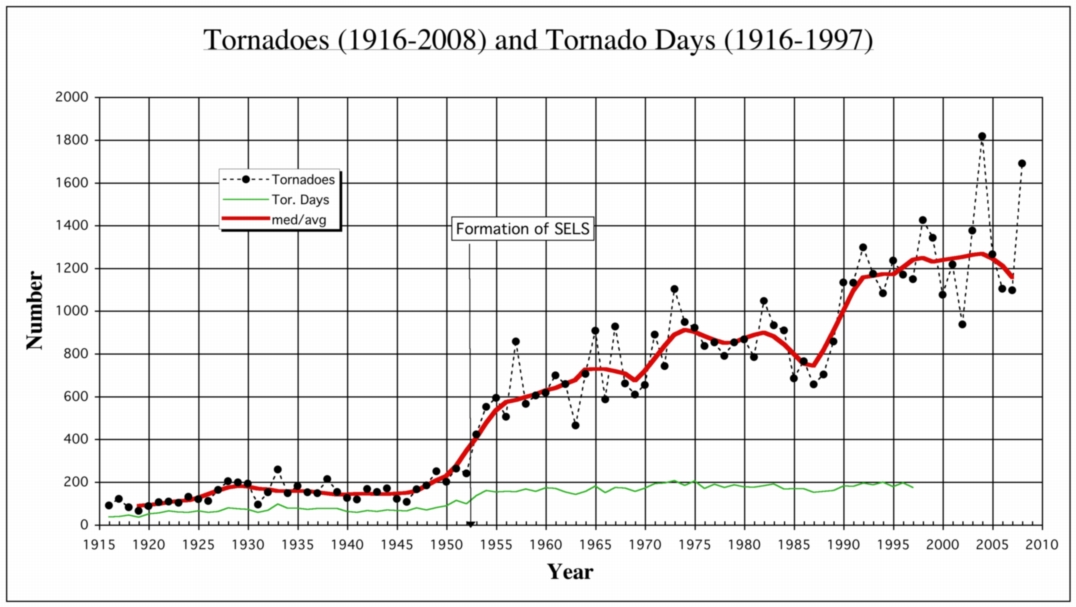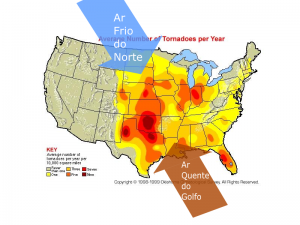A tornado is a meteorological phenomenon which is formed by an air column that it turns around at high speed, it is violent and potentially dangerous. The tornadoes can occurs in any place of Earth, with exception to the polar region. However, in the USA, particularly in a region called Tornado Alley, this kind of nature's force has a higher number of events.
Apparently tornadoes are attached to a strong interaction between the mass flow of air upward and downward and cause an intense movement in the center of clouds of super-charged storm cells. These cells usually formed due to the contrast between two large air masses at different pressures and temperatures.
After touch down, a tornado can reach a range between 100 to 1200 meters, moving a length of approximately 30 km.

Formatio of a tornado. Credit: wikimedia
1 - Prior to the development of the storm, a change in wind direction and speed with an increase in the height tendency to create a horizontal rotation in the lower atmosphere. This change in direction and wind speed is called wind shear.
2 - Air ascending from the lower atmosphere enters the storm and the air rotating inclined from the horizontal position to the vertical position change.
3 - Then there is the formation of a rotation area with a length of 4.6 km, which corresponds to nearly entire length of the storm. Most strong and violent storms are formed in these areas of extensive rotation.
4 - The cloud base and its area of rotation are known as wall cloud. This area is generally no rain.
Reference: wikipedia
As I said before, it is in the US were the number of this event s are higher. Despite a decrease in the number of victims, the number of tornadoes has been increasing over the years.

Number of tornados in USA, between 1918 and 2008. Credit: Chuck Doswell

Air cold from North and Warm from South. Font: Oklahoma Climatological Survey. Adaptation: José Gonçalves
This phenomenon occurs in large numbers in the United States due to large cold air masses coming from the north and warm air masses coming from the Gulf of Mexico. As this aisle there are no major natural barriers such as exists in the West, we have a great area where these masses can collide and form the super storm cells and that will become responsible for the emergence of tornadoes.
However, despite the increased number of tornadoes, the number of tornadoes with great destructive power has decreased compared to previous decades.

Tornadoes can be classified regarding their destructive power. This scale is known by the Fujita scale.
In the table we have the scale and its relationship to wind speed, track width, track length and damage.
The maximum value defined so far is F5, where the wind velocity may reach values between the 420 and the 530 km / h. (260 to 329 mph)
| Classification | Velocity of winds (km/h) | Base of the tornado (meters) | Track (km) | Damage |
|---|---|---|---|---|
| F0 | 65-115 | 3-20 | 0-2 | Light |
| F1 | 115-180 | 10-100 | 1-5 | Moderated |
| F2 | 180-250 | 50-500 | 2-20 | Strong |
| F3 | 250-330 | 500-1000 | 5-60 | Severe |
| F4 | 330-420 | 1000-2000 | 10-150 | Devastating |
| F5 | 420-530 | 2000-5000 | 10-500 | Massive destruction |
Table: Fujita's scale, correlation with another characteristics of the tornados.
In this graph we have the classification of the tornadoes and the number of events since 1950's.
Number of tornadoes and its classification since 1950's. Credit: Harpers-Ferry Weather
The phenomenon in the United States have been monitored in recent years with some concern. This seems to come from the fact that these phenomena are occurring earlier than normal for its season and a very large number.

In the graph there is the anomalous 2008 and 2011. This year could set a new record for the number of tornadoes that occurred in the United States.
Versão portuguesa aqui.



No comments:
Post a Comment